Home » Best Places to Visit and Attractions
If you’re looking for the absolute best places to visit in Malta and Gozo, you’ve come to the right place.
This big list of Malta’s best tourist attractions offers you the best options for tours and excursions and things to do across the Maltese islands.
Being small, it’s easy to fit in a number of the best places to explore in Malta in a single day at an easy pace. With relatively short distances between the various sights, you get to see more than in most other travel destinations in Europe.
Here’s my personal selection of the attractions in Malta I recommend visiting!
Looking for museums specifically?
Check out this article: The 29 Best Museums in Malta.
This little island nation has a lot to offer the curious traveller, with a rich, fascinating history and traces of various cultures and foreign rulers who left their mark on Malta and its culture. Malta is awash with various places to see within old village cores, the countryside and the Mediterranean Sea, allowing visitors to delve into the country’s past, get to know its art scene, and imagine times gone by.
Aside from places to visit, there are also a lot of things to do in Malta that are worth exploring.
This list of recommendations for the best places to visit in Malta is based on personal experience as an expat-turned-local. There are more options out there, but I feel these are the places I would recommend that are worth your time and money on your visit to Malta.
If you only have one or two days to visit a few places in Malta and Gozo, my recommendations are:
If sightseeing is a priority for you on your Malta holidays, Valletta should definitely make it onto your itinerary. The capital is home to some of the top tourist attractions and best places to explore on the island of Malta, and the city itself is full of historical buildings which are all easy to reach on foot.
Here is my list of the best cultural attractions and points of interest in Valletta. The below is a starting point, but you can find more info on the best places to visit and things to do in Valletta here.
Location: St. John’s Square
The St. John’s Co-Cathedral is an absolute must-visit. Not just for its amazingly beautiful interior and Baroque architecture but also for the collection of Caravaggio (Michelangelo Merisi) works on display at the museum.
The cathedral was built by the Knights of the Order of St. John, who played a hugely important part in Malta’s history, and you will hear stories of them popping up all around the island. St. John’s Co-Cathedral and Museum is dedicated to this section of Maltese history and highlights the roles and lives of the Knights who once called it their home.
Location: Old Theatre Street
Notable for its diverse range of plays, the Manoel Theatre is also a huge hit on the island of Malta because of its exceptional design – it really is an architectural gem. With elaborately decorated domed ceilings and rows of boxed seating sporting intricate patterns, it’s truly a place to behold and admire. Don’t forget to look up towards the ceiling!
Inside the ornate architectural beauty of the Manoel Theatre and Museum, visitors can rest and relax in the Roman-inspired central courtyard that offers a peaceful, well-designed haven.
The small square is also used to display art exhibitions, providing a creative space to think and chill out.
Location: Triq San Pawl (towards the middle of this long street)
The first time I visited the church of St. Paul’s Shipwreck, I wasn’t expecting to find anything out of the ordinary, but to me, it’s a bit of a hidden gem in Valletta. A gem that needs polishing, but the interiors are unique and fascinating.
It’s a dimly lit church during the day, and restoration works are being carried out, but there’s a lot of detail in the shrines, ceilings and floors to discover. Step inside and have a look for yourself!
Location: Starts at Castille Place, ends in the North of Valletta at Fort St. Elmo
Merchants Street is one of Valletta’s longest streets, where you can find a bit of everything: Historical buildings, churches, cafes with their street terraces and side streets with quirky little shops. Have a look at the university campus.
Location: The tip of the peninsula of Valletta
Fort St. Elmo is one of the most significant fortifications in the Grand Harbour area. The fort’s predecessor (also referred to as Fort St. Elmo) played a key role in the defeat of the Ottoman army during the Great Siege of Malta in 1565, despite having been reduced to rubble.
While the construction of Valletta started the following year, Fort St. Elmo was rebuilt and integrated with Valletta’s fortifications.
The upper part of the fort was restored between 2009 and 2015 and has become a popular point of interest in the capital, also hosting the National War Museum within some of the barracks.
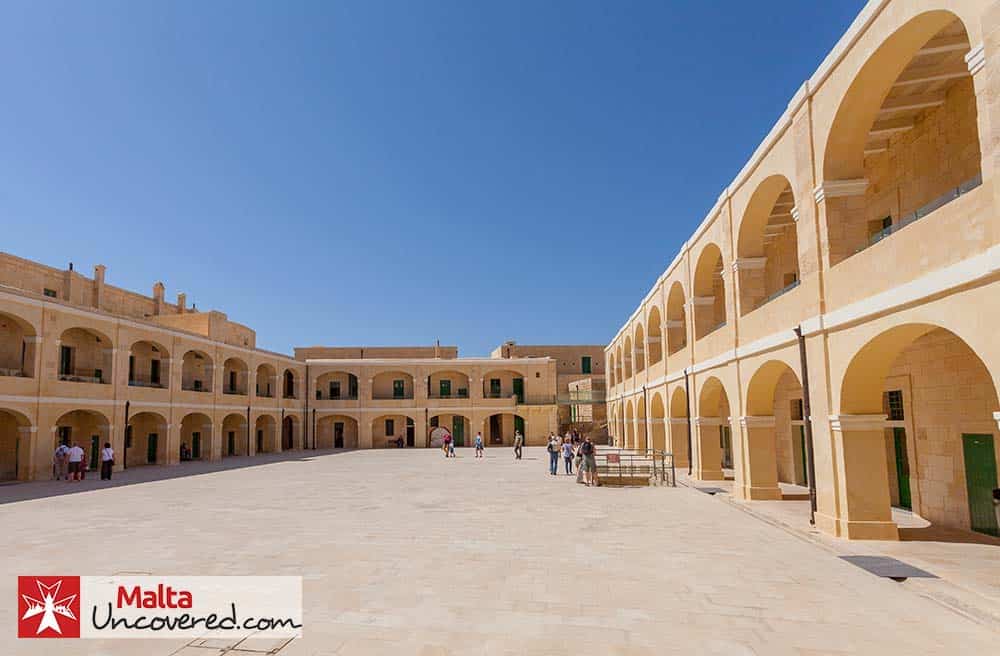
Location: Behind Fort St. Elmo
If you’re a little more adventurous and don’t mind heading off the beaten path, you can get to the Breakwater Bridge at the entrance to Grand Harbour, just a few minutes walk around to the back of Fort St. Elmo.
Access to the far end of the breakwater is usually closed, and the bridge itself isn’t the main draw. The view you get out over the harbour and the location itself is special and worth checking out.
Location: Quarry Wharf, near Triq il-Mediterran
Not far away from Fort St. Elmo, the Siege Bell War Memorial sits on the edge of the Valletta bastions, overlooking Grand Harbour and its breakwater. The bell itself was built to commemorate the award of the George Cross to Malta and to honour over 7,000 Service Personnel and Civilians who gave their lives during World War 2.
Location: South-east of Valletta, shown as a roundabout between Pope Pius V Street and Triq San Pawl
Castille Place is the square located in the Southeastern corner of Valletta, which is one of the few access points for vehicular traffic into the capital. Apart from providing a lovely scene itself, you can find a few interesting buildings at this location.
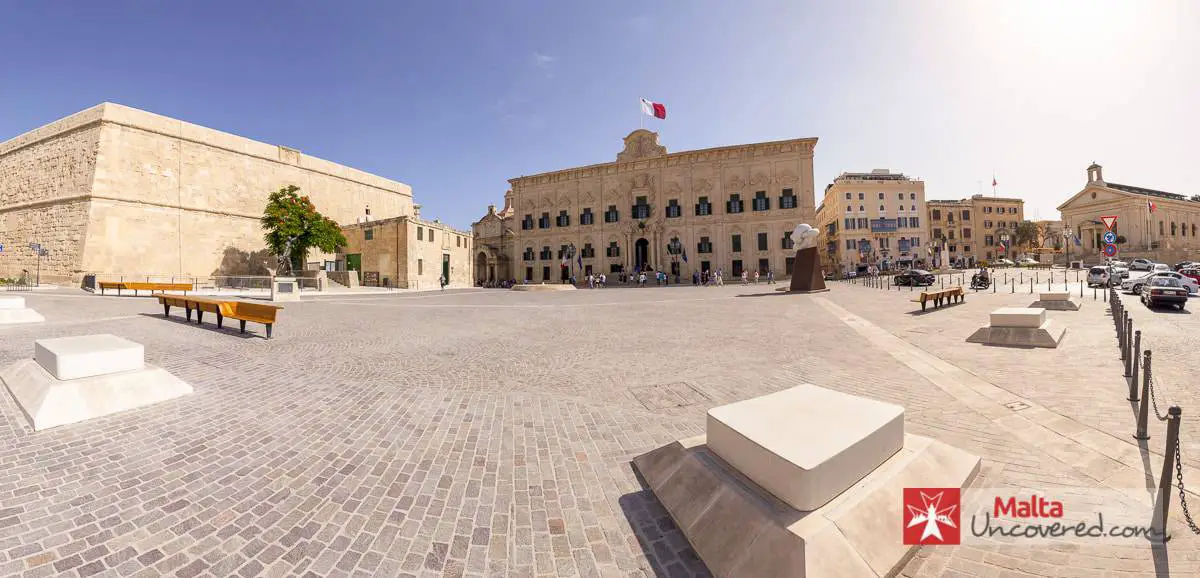
Get my recommendations on the best day trips, boat trips, excursions and activities and book in advance!

Location: Castille Place
Website: www.kreattivita.org/en/
Back at the turn of the 21st Century, St. James Cavalier was converted into a Centre for Creativity, and old, cobbled passageways and large, high-ceiling rooms were renovated into spaces for contemporary art exhibitions and cultural events.
Aside from its unique interiors, events and performances are regularly held here.
Location: In the southern-east corner of Valletta
The Upper Barrakka Gardens is one of the most popular spots in the capital city, from where you can get splendid views out over Grand Harbour. It’s also a great place for a quick drink and a snack at the local kiosk overlooking the gardens.
This location is also an entry point from the harbourside (and its cruise port near the Valletta Waterfront) down below through the Upper Barrakka Lift, which ascends the height of the bastion wall of over 58 metres.
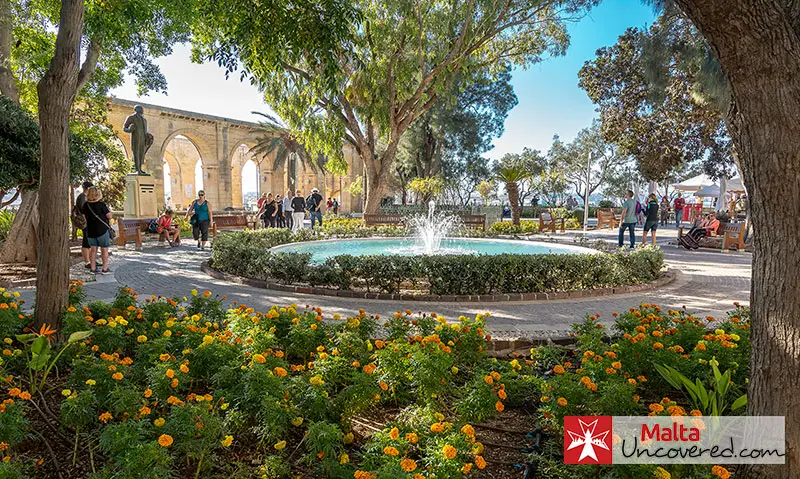
Location: Upper Barrakka Gardens
With a great vantage point over Grand Harbour, the Saluting Battery was built by the Knights in the 16th century and used by the British as an artillery battery until the 20th century. Recently restored, you can get a tour around the location and one of the guns located there is fired twice a day, at noon and 4 p.m.
You can access the Saluting Battery by descending a few steps in the middle of the Upper Barrakka Gardens.
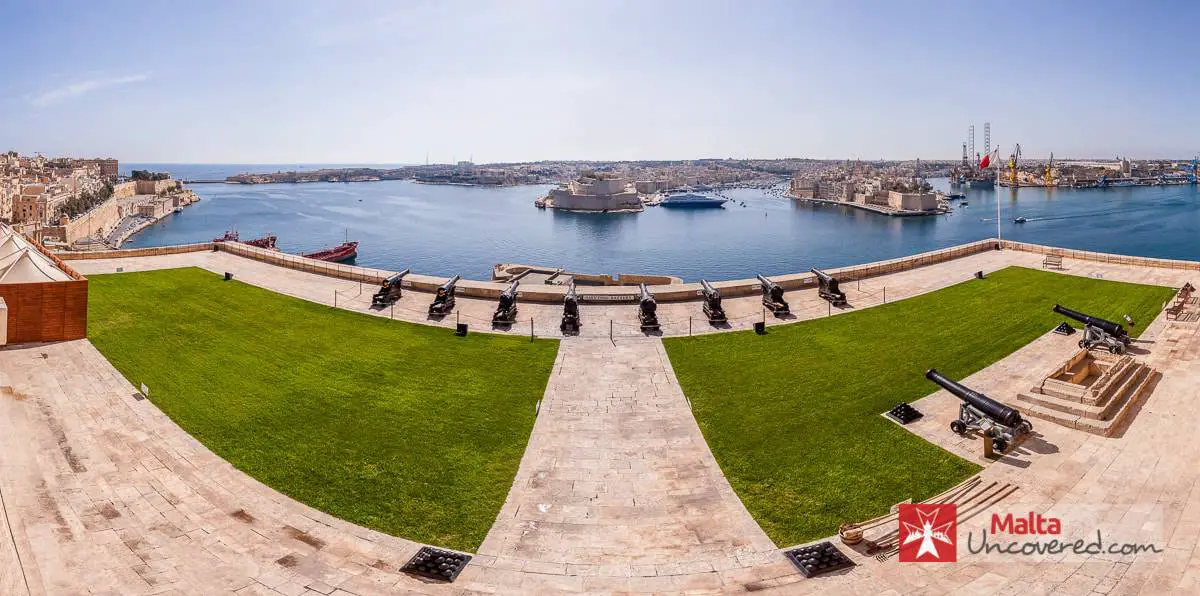
Location: Triq Lvant (found as ‘Lvant’ on Google Maps)
Less popular and smaller than its Upper cousin, the Lower Barrakka Gardens is a peaceful little haven to have a quick break and enjoy the views (and shade!) with a drink and a snack from the kiosk present near its entrance.
Location: 74, Republic Street
Casa Rocca Piccola is an immaculately maintained historical palazzo and home to the de Piro family. It gives you a rare view of how the aristocracy of Malta lived during the time of the Knights of Malta.
The rooms that are accessible to the public are set up beautifully to offer a glimpse of what it must have been like to live there, and with a guided tour, you’re also offered access to the WWII shelters underground through the palace’s courtyard.
Location: Mediterranean Conference Centre, Triq il-Mediterran
Formerly a state-of-the-art hospital built by the Knights of Malta in the late 16th century, La Sacra Infermeria (nowadays Mediterranean Conference Centre) is one of the most impressive buildings in Valletta. There are two ways to get to see La Sacra Infermeria from inside:
Location: Just outside of Valletta, towards the South (10-min walk)
The Valletta Waterfront (really and truly situated as part of the neighbouring village of Floriana) is a small area on the harbourside with a row of buildings once used for storage and customs. Restored in recent years, with colourful doors and apertures, the stores now house several restaurants and entertainment establishments.
With shaded terraces out front, it’s a lovely place for a bite to eat and a drink with a view over Grand Harbour. After you take the Upper Barrakka lift down to the harbour, it’s a 10-minute walk with interesting sights to take in along the way.
Location: Grand Master’s Palace, Palace Square
Housed within the Presidential Palace in the centre of Valletta, the beautiful interiors of the Palace State Rooms are a sight to behold.
Having been the residence of successive Grand Masters and Governors during British rule and nowadays the President’s Palace, the building is a magnificent piece of heritage with art adorning almost every wall.
Location: Old Treasury Street
Website: https://maltalibraries.gov.mt/
Between the President’s Palace and St. John’s Co-Cathedral, you’ll find the National Library of Malta and its square featuring a statue of Queen Victoria. The main reading hall is usually open during the day (full days in winter on weekdays, mornings only during the summer months), and it’s worth looking inside to admire its interiors.
This library isn’t your typical public library. Instead, it houses manuscripts, printed books, periodicals and journals issued in Malta and is the main source of Melitensia (which refers to the written collections of the history and culture of the island of Malta).
Although it’s a relatively small village across the Grand Harbour from Valletta, there’s a lot of historical value in Birgu (Vittoriosa). The place once formed the headquarters of the Knights of St. John (in the 16th Century) before Valletta was built.
Location: Main Gate Street
In the 16th Century, the Grand Inquisitor’s Palace was built to accommodate the civil law courts.
Today, the building is used as a portal to the past, displaying incredible works of art in gold, gilded frames, and a selection of furniture and artefacts reminiscent of the time shortly after the Knights turned up on the island of Malta.
Location: Couvre Porte Gate
In preserved, underground bomb shelters and through a vast selection of memorabilia, visitors to the Malta at War Museum can learn more about the island’s role in World War II and the great suffering that racked the island – a moving and fascinating experience.
Location: Ex-Naval Bakery
Malta has a rich maritime history at the heart of the Mediterranean Sea. At this museum, you can get a thorough understanding of 7,000 years of maritime history and the many civilisations that sailed the Mediterranean Sea. With several interesting artefacts and an inviting setup, it’s a great museum to explore.
Location: Birgu waterfront
Having undergone major restoration in recent years and getting a new museum set up within its thick walls, Fort St. Angelo is a magnificent part of the fortifications around Grand Harbour. The exact time during which the first stone was laid is unknown, although most dates point back to the 13th century.
When the Knights of Malta arrived in 1530, this fort became the seat of the Grand Master and withstood an invasion by sea from the Ottoman Empire in 1565.
An impressive complex worth visiting and exploring!
The quiet towns of Mdina and Rabat can be found in the Western part of the island of Malta and offer a lot in terms of historical sites and cultural attractions. With some of the most interesting points of interest around the Maltese islands, this is a must-visit place.
Sitting on top of a hill near Rabat, the fortified medieval city of Mdina is one big museum and one of my favourite points of interest on the island of Malta. Beautifully maintained, it was once Malta’s capital city until the arrival of the Knights of Malta in 1530 and has maintained its medieval character through the centuries.
It is literally like stepping into a scene of days gone by, strolling through its narrow, winding alleys with different types of architecture and living up to its name, “the silent city”. This must-see has been placed on the tentative list of UNESCO World Heritage Sites.
Location: St. Publius Square, Mdina
Located right behind Mdina’s main gate lies the National Museum of Natural History. Although the museum and its contents aren’t the best on the island, it is worth visiting for the building itself. Indeed, the museum is housed in the Vilhena Palace, built in 1724 by Grand Master Antonio Manoel de Vilhena in the Parisian Baroque style.
The collection ranges from beautiful butterfly collections to weird and wonderful examples of taxidermy. The interior of the National Museum needs a bit of TLC and dusting, however, so don’t expect a polished museum.
Location: Triq Il-Villegaignon, Mdina
Tucked away in one of the main streets in Mdina, the Chapel of St. Roque looks unassuming from the outside but offers beautiful interiors, particularly the altar. It’s a little-known chapel that doesn’t look particularly inviting from the outside but is definitely worth a quick visit!
Location: Triq is-Sur, Mdina
With Mdina being located on top of a hill, there’s a very rewarding view out over the North of Malta from Bastion Square, which you can find towards the northern side of Mdina. Avoid sitting on the bastion walls – it can be dangerous!
Like the view and up for a coffee and a snack? Head over to Fontanella Tea Garden, a cafe located around the corner from this square with an outside terrace offering a similar view and some of the best sweets in the area.
Location: Entrance from the ditch near the southern side gate (parking area) or next to the il-Veduta restaurant at street level, to the East of the main gate of Mdina.
As part of a recent extensive restoration project of Mdina, the bastion city’s large ditch also got a major facelift. Although the garden itself makes for a nice walk or place to chill in the shade, if you walk around the corner to the East, there are some nice views to take in as well. It’s not a well-known spot, so expect peace and quiet!
Location: Pjazza San Pawl, Mdina
St. Paul’s Cathedral is the most dominant feature of Mdina’s skyline and looks just as impressive as the square in front. It’s more or less the city’s central point and contains several intricate frescoes and paintings that make for a very rich interior. Further artworks and artefacts are on display in the small museum next door, housed in the Seminary.
Location: Ħal-Bajjada, Rabat
If you are into archaeology, make a stop at St. Paul’s Catacombs during your visit to Mdina and Rabat. This complex of interconnected underground Roman cemeteries stands as the earliest and most important archaeological evidence of Christianity.
St. Paul’s Catacombs were in use up to the 7th (or even the 8th) century AD and are located in an area with more than 30 hypogea. Its connection to the saint originates from the legend suggesting that this group of catacombs was formerly linked to St. Paul’s Grotto.
You can also visit the smaller and lesser-known catacombs of St. Agatha and St. Cataldus, the first having interesting frescoes.
Location: Outskirts of Rabat
Buskett is probably the closest thing to a forest on the island of Malta in an otherwise fairly barren landscape due to the climate. The gardens were once an area of recreation and hunting grounds to the Knights, and apart from their natural beauty, Buskett features a few old structures, orchards and pathways. It’s a peaceful location often enjoyed by locals for picnics and Sunday walks, ideal for some off-the-beaten-track Malta sightseeing.
One of the major reasons people visit Malta is the fact that there are so many places to see (and so many things to do) within close proximity of each other.
The following part of this list of best places to explore in Malta and Gozo, although spread out across the islands, are easy to reach and worth visiting.
The Three Cities refers to the three major localities opposite Valletta, across Grand Harbour: Senglea (aka Isla), Birgu (aka Vittoriosa) and Bormla (aka Cospicua). Although Birgu has the most to offer regarding points of interest, it’s worth walking around all three villages when visiting Malta. They’ve got a particular, quaint character with great harbour views (particularly from near the Gardjola watchtower at the tip of Senglea) and interesting photo opportunities if you like taking pictures.
Location: Victory Square, Naxxar
One of the hidden gems on the island of Malta is the Palazzo Parisio, located in Naxxar. The Portuguese Grand Master Manoel de Vilhena built this extraordinary piece of architecture back in 1733, during the era of St. John’s Knights. Since then, it has been renovated and embellished and is now a beautifully ornate stately home, complete with unique interiors and a fascinating history to go with it.
Outside, you will find beautifully manicured gardens designed following the Italianate tradition.
Their cafe is also a nice place to sit down for a cup of coffee or tea and a snack.
When going out of the Palazzo, take some time to admire Naxxar Parish Church, dedicated to the Nativity of Mary, and go inside if it’s open. The Parish Church’s rich baroque interior is well worth a visit.
Location: Anchor Bay
Set on the original set of Popeye (a 1980 movie starring Robin Williams), Popeye Village is a small theme park that is a staple attraction for most travel guides. Although, if you have kids, Popeye Village is a nice place to visit (despite the cartoon character being a little dated, perhaps), the location at Anchor Bay is amazing.
Curious to see what Popeye Village is like without going inside? Just stand on the cliff opposite the village and take some memorable pictures! The most common Popeye Village photos are actually taken from that viewpoint and many tourists come to this bay for that very reason when they visit Malta.
It’s a quiet part of Malta with a few beautiful unspoilt areas, and this particular rocky bay is great for snorkelling. There’s no beach, but there’s an easy entry point from the opposite of Popeye Village. You can get onto large cement blocks where the ferry to Gozo used to berth. Keep an eye on the wind direction if you decide to go snorkelling here, though the sea can get pretty rough!
Location: Corner of Triq Raddet ir-Roti, Xemxija
If you’re into exploring some of Malta’s nature “off the beaten path”, this is a good option for a walking route where remains can be found of a Roman-era road and buildings, as well as bronze-age caves used as beehives.
It’s a steep uphill walk, but you’re rewarded with a great view over Xemxija and St. Paul’s Bay. When you get to the top and further behind the trail, there are some nice paths to follow through the countryside.
Location: Church Square, Mosta
The Mosta Dome (aka Mosta Rotunda) has what’s believed to be the third-largest unsupported dome roof in the world. Apart from its impressive architecture and interiors, its history could have unfolded very differently had the 200kg bomb that the German Luftwaffe dropped in 1942 (during World War 2) detonated. Instead, it pierced the roof and fell amid a congregation of some 300 people but failed to explode. Miraculously, no one was injured.
The Mosta Dome is also where one of my favourite festi (plural of festa) is organised on the 15th of August each year. Festi are religious festivals held in every village throughout the summer.
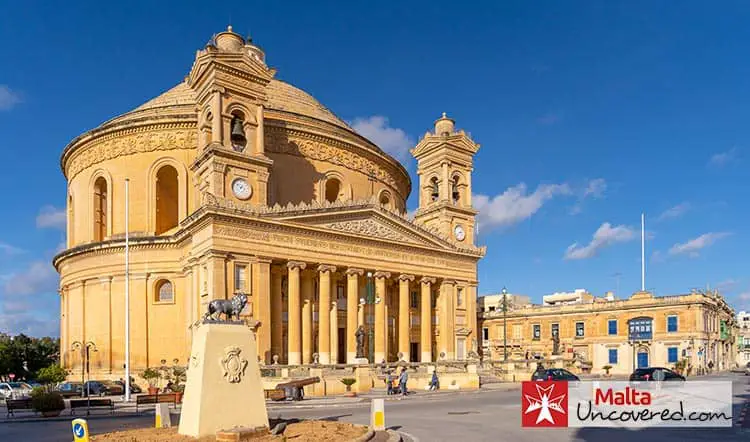
Location: Ta’ Qali
The Aviation Museum is a must-visit for flying fanatics. Set in a former Royal Air Force Station, the museum features a variety of aviation vehicles and accompanying relevant objects that are of great historical importance to Malta.
Location: Ta’ Qali
If you’re looking for a few nice souvenirs, you’ll find some traditional hand-made Maltese crafts at the Ta` Qali crafts village, formerly homed in old army barracks constructed by the British. The village has undergone renovation and is now made up of larger traditional Maltese buildings.
Pottery, glass, jewellery, lace – there’s something for everyone, and it’s genuine, unlike some of the plastic rubbish you’ll come across in tourist areas.
Location: Ta’ Fra Ben Point, Qawra
With more than 50 display tanks, the Malta National Aquarium at Ta` Fra Ben, Qawra, is home to several species of fish and other sea life, most commonly found in Maltese waters, as well as other creatures like reptiles, insects and amphibians. A fun family outing that is easy to reach.
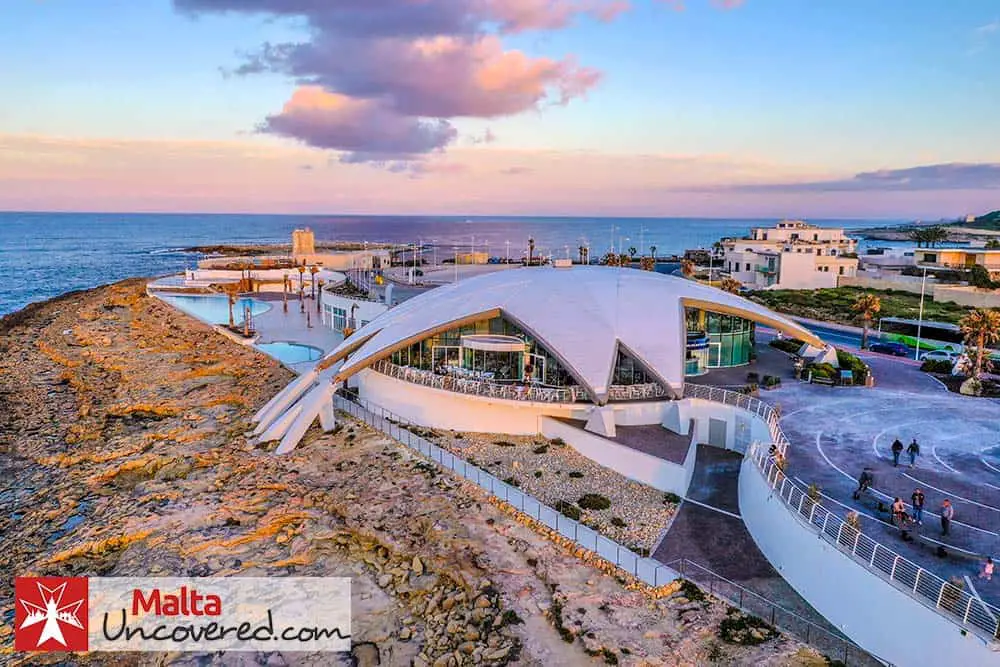
Location: Marsaxlokk
Marsaxlokk is known as one of the few remaining examples of a traditional fishing village in Malta, and apart from boasting some of the best fish restaurants on the island, it also hosts a fish market on Sundays.
There is also a smaller market from Monday to Saturday, where you won’t find fish but souvenirs, clothes, ornaments, some food… (don’t expect to find very special items though).
It’s a nice place to visit along the South coast of Malta island, with a small harbour full of colourful fishing boats, also called luzzu (pron. ‘lutsu’). You can easily combine a visit here with a boat ride at the Blue Grotto (further below).
Feeling a bit adventurous? Explore the Delimara Peninsula on foot, located to the west of Marsaxlokk. There you will find St Peter’s Pool, a natural swimming pool, and other secluded bays ideal for swimming and snorkelling. St Peter’s Pool doesn’t have sand but there is some space on the rocks to spread your beach towel.
Location: Wied iż-Żurrieq
Another beautiful location to visit at sea is the Blue Grotto, located near the village of Zurrieq in the South of Malta. You can take a boat trip into those beautiful sea caves along the coastline during the summer months to admire the bright hues of blue caused by sunlight reflecting off the sandy seafloor underneath.
I advise you to come to the Blue Grotto in the morning, as it is when the colours are at their best.
Also a popular diving location, it is accessible through locally organised boat tours that take you in and around the Blue Grotto and nearby caves to give you a good view of the beautiful coastline in this part of the island.
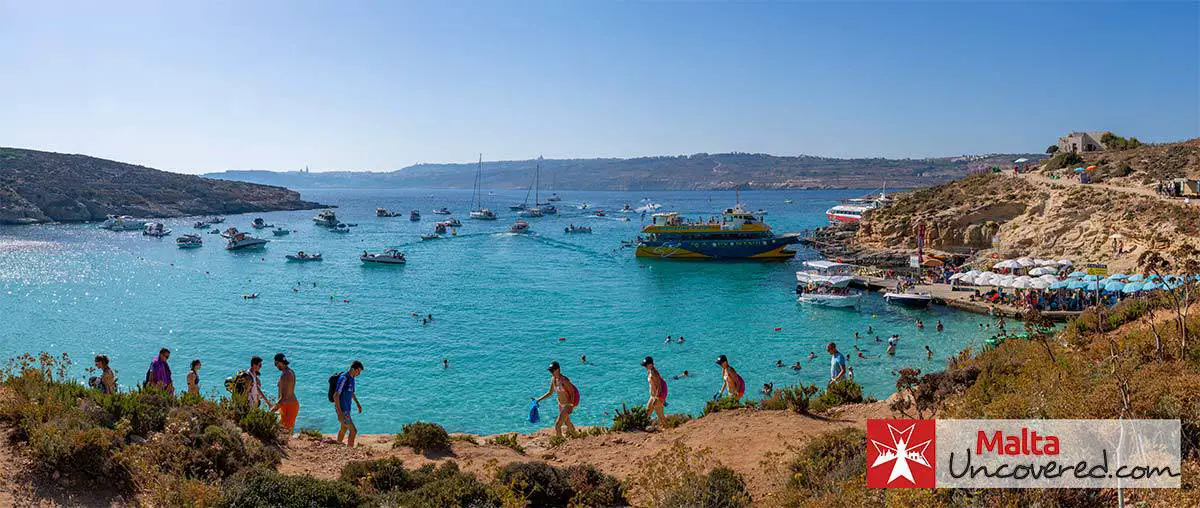
Get the best travel tips from Malta Uncovered delivered to you in bite-sized chunks by email. (Unsubscribe at any time!)
Location: Mellieħa and its outskirts, North of Malta Island
If you wish to spend some time at the beach during your holiday in Malta, there are some nice sandy beaches located in the north of the island. Here are my three favourites, all recognised for having clean bathing water and that are Blue Flag certified.
Located on the west coast, Golden Bay is the most popular one among tourists and locals alike. As the name of Golden Bay Beach suggests, it boasts inviting golden-coloured sands and it is easy to access either by public transport or by car. Golden Bay Beach has all the amenities: water sports, ice cream shops, restaurants, parking and even a five-star hotel.
Next to Golden Bay Beach is Għajn Tuffieħa (also known as Riviera Bay), my absolute favourite beach in Malta. This beach is the perfect balance between relatively untouched nature and facilities one can expect to find at a beach. It might be a bit less accessible than Golden Bay Beach due to the numerous steps that lead to it, but the views are definitely rewarding. If you prefer hiking, there is a hiking trail running at the back of the beach.
The third sandy beach I want to mention is Mellieħa Bay (or Għadira Bay), the largest sandy beach in Malta. This beach is easy to access, family-friendly and has all the amenities.
Location: Outskirts of Dingli
If you like nature and walks, Dingli Cliffs are a place you may consider visiting in Malta. Those 200-meter cliffs plunge dramatically into the Mediterranean Sea and are the highest point of Malta.
The area offers good opportunities for hiking while enjoying panoramic views over the sea and Filfla (an uninhabited and protected islet). You can even hike from Buskett Gardens (see higher up) to Dingli Cliffs: the walk takes between 30 and 40 minutes.
Dingli Cliffs are also popular among locals and tourists alike for sunsets. What better way to end a day of exploring?
Good to know: Although it’s a nice place to enjoy nature, it isn’t easy to reach by public transport. If you’re driving a rental car, it’s easy to reach, but otherwise, other places of interest may be more worthy of your limited time in Malta.
Gozo is Malta’s much smaller and quieter sister island and offers various points of interest and places to visit that are worth exploring, even if only as part of a day trip.
Location: Outskirts of Għarb
The Basilica of the Blessed Virgin of Ta’ Pinu is one of Gozo’s most easily recognised landmarks.
Although the church and its surroundings are more than enough reasons for a visit, the sanctuary inside is the biggest draw for most.
There, you’ll find items on display that testify to the gratitude towards Our Lady of Ta’ Pinu. Items like helmets, letters, crutches and clothes tell the stories of local devotees of prayers heard and fulfilled.
The parvis is adorned with colourful mosaics featuring representations of the 20 mysteries of the rosary.
Location: Victoria (in the centre of Gozo island)
Similar to Mdina, Gozo’s capital city of Victoria has its own citadel, perched on top of a hill more or less at the centre of the island, overlooking most parts of the surrounding areas and is freely accessible.
Also placed on Malta’s tentative list of UNESCO World Heritage Sites, it was known as Gran Castello in Medieval times and protected its citizens, as well as those of the extension of the city that started forming outside its walls in the 16th century, from corsairs and other invaders. Beautifully restored in recent years, it’s a lovely place to wander around and explore.
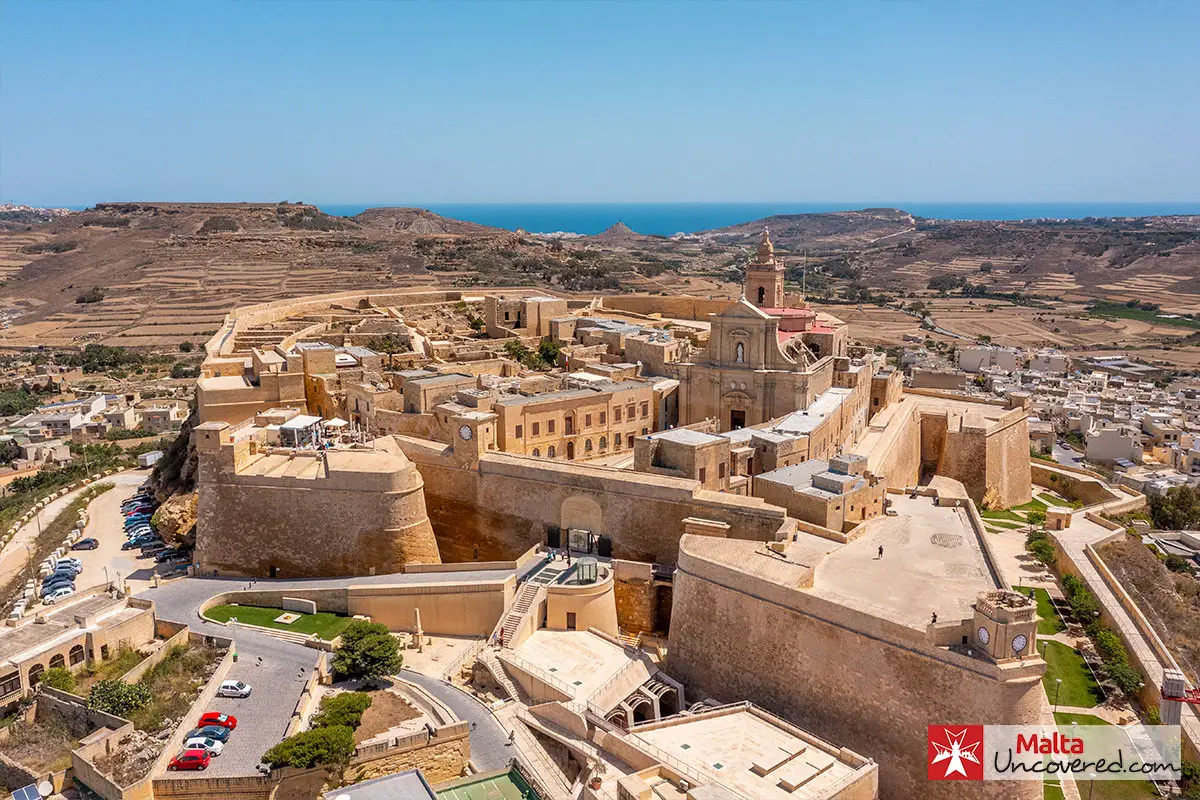
Before you explore the Citadel, pay a visit to the Cittadella Visitors’ Centre, located below the Citadel’s gate. They’ve done a great job explaining the place’s history and its hugely important role in protecting the local population over the centuries.
Buying a combination ticket here gives you access to all the below museums located within the Citadel’s walls (except for the Cathedral Museum).
Location: Victoria Citadel
With over 2000 items on display, the Cathedral Museum provides an expansive insight into Malta’s history, culture, and traditions. From beautiful paintings by famous local artists to fascinating archives and a silver vault, there are numerous ways for visitors to get to know Malta here.
Location: Bernardo de Opuo Street, Victoria Citadel
Malta has a rich and varied history, and the Folklore Museum paints a great picture of times gone by, including representations of rural and domestic living, traditional clothing, and tools that have been a huge part of Maltese life over the last few centuries.
Location: Victoria Citadel
Showcasing the historical timeline of Gozo, the Museum of Archaeology is a series of well-laid-out rooms that depict the cultural history of the islands, from prehistoric eras right up until the present day. This is the place to go for a comprehensive lesson on how Gozo got to where it is today.
Location: Victoria Citadel
Set in an old, charming house from the Aragonese period, the Museum of Natural Science displays a selection of mind-blowing exhibitions, including fossils, gemstones, and artefacts of great scientific importance.
Location: Victoria Citadel
Visitors to the Old Prison can sneak a peek into the lives of former criminals who were held in the grand, old building by the Citadel. The law courts are nearby – for obvious reasons – and visitors can see the important Cathedral Square from the windows of the prison.
Location: Pjazza San Gorg, Victoria
This interactive museum in the heart of rustic Gozo Island focuses on fine art and the history of the Maltese islands, with fascinating audio-visual halls spread out over every floor, including an impressive medieval wing.
Location: Xlendi (village)
The small village of Xlendi is located in the southwest part of Gozo and overlooks a small bay flanked by tall cliffs. There’s a small bay lined with a few restaurants and hotels, which are great for a relaxed lunch while enjoying the view over the bay. Scuba divers also enjoy this bay where are laying some reef formations.
Location: Dwejra, on the outskirts of San Lawrenz
Dwejra and its Inland Sea are a popular attraction in Gozo. This was also the site of the famous Azure Window (a naturally arch-shaped rock formation), but this popular landmark eroded into the sea in early 2017 during a spell of bad weather and rough seas. That specific part of Dwejra was one of the most iconic filming locations for the first season of Game of Thrones.
Nevertheless, it’s still a great location for scuba diving and snorkelling, as well as ramblers exploring the beautiful underwater life and its rugged landscape. The Blue Hole, located right in front of the place where the Azure Window was once standing, is one of the most popular diving sites on the island.
The Inland Sea itself is a small bay surrounded by tall cliffs where you can go for a swim but it is more enjoyable for snorkelling, also because the bottom is pretty rocky and the beach is covered in pebbles rather than sand.
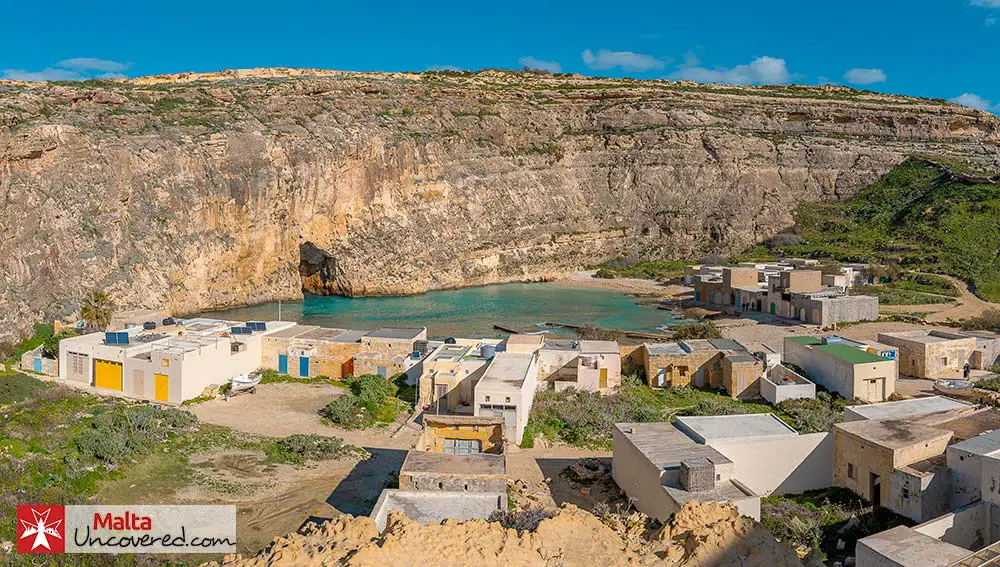
Location: Outskirts of Xagħra
Ramla Bay (also called Ramla l-Ħamra) is the largest sandy beach in Gozo and is mostly unspoilt by man. This lovely beach has reddish sand, as its Maltese name (Ramla l-Ħamra) suggests, contrasting with the turquoise hues of the sea.
Ramla Bay is Blue Flag certified, has a lifeguard on duty during the summer months and has several facilities, making it a family-friendly beach.
The beach is framed by two natural caves offering stunning panoramic views over the bay: Calypso Cave and Tal-Mixta Cave.
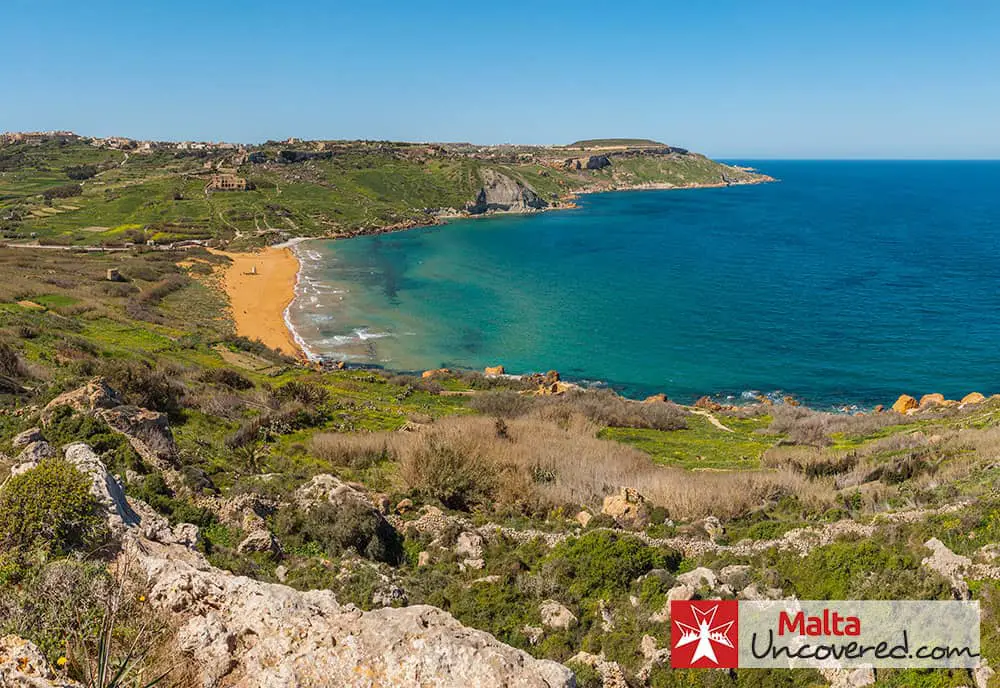
Some of the prehistoric Maltese temples found scattered around the Maltese islands are older than the Pyramids of Giza in Egypt and Stonehenge in the UK, the oldest having been built around 3600 BC. They’re among the oldest free-standing structures in the world, and paying a visit is well worth the excursion if history and archaeology are among your interests. None of the temples is located close to the more popular tourist areas, although public transport services most quite well.
If I had to choose one location to recommend going to view some of the temple structures, it would be the ones located near Qrendi (a quiet village in the South of Malta). The Ħaġar Qim and Mnajdra temples are located nearby, and the visitors’ centre makes for an interesting visit with good info on the temples, who built them, what they were used for, etc.
If you’re into history and archaeology, the Megalithic Temples of Malta can give you a fascinating look at early records of civilisation in the Maltese islands. Together listed as UNESCO World Heritage site, the various temples are some of the world’s oldest free-standing, man-built structures.
Location: Neolithic Temples Street, Tarxien
The Tarxien Temples are a complex featuring four magnificent megalithic structures designed and erected between 3600 and 2500 BC. The site provides visitors with a fascinating and humbling look into the prehistoric life of Malta.
Location: Triq Ic Cimiterju, Paola (Raħal Ġdid)
The Ħal Saflieni Hypogeum is an ancient burial site that was discovered during an excavation in 1902 and, today offers visitors the chance to explore a complex of interconnecting tunnels and burial chambers. Remains from the early temple period have been found from around 4000 BC, hinting at the first human life in Malta.
Location: Triq Ħaġar Qim, Qrendi
The archaeological site of prehistoric Ħaġar Qim Temples stands proudly on a hilltop with spectacular views out to the Mediterranean Sea. Here, visitors can wander around a series of prehistoric settings and learn more about early human life in Malta.
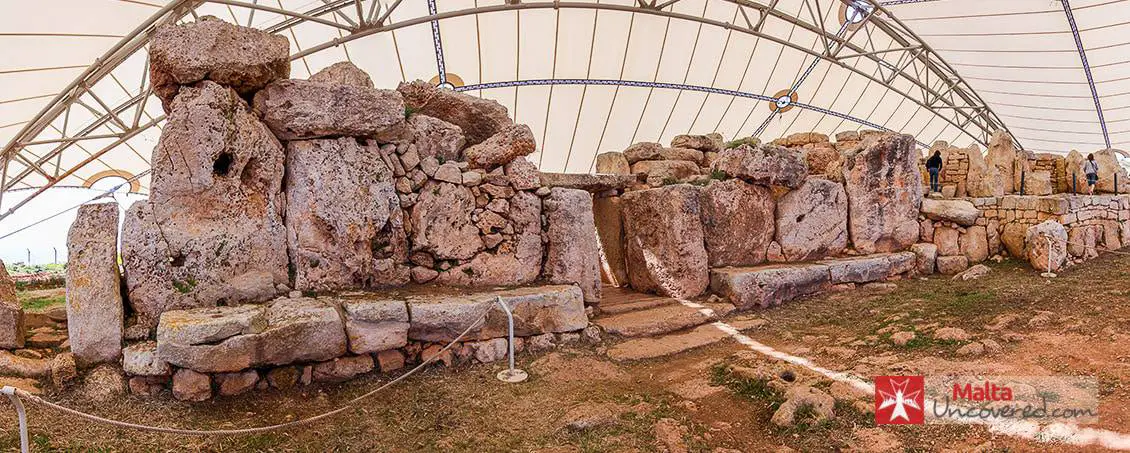
Location: Triq Haġar Qim, Qrendi
Hauntingly set on the rugged Maltese coast, the Mnajdra Temples are located near the Ħaġar Qim temples. The complex consists of three structures and offers visitors the chance to see some unusual design styles from the prehistoric period. The most interesting one is the South Temple, as it was built in a way to mark the first day of each season.
Location: St. Peter Street, Mġarr
This exceptional structure is one of the oldest free-standing sites of its kind in the world, making it an extremely important addition to Malta’s temple collection. At Ta` Ħaġrat, visitors can enjoy the stunning views available from the complex and experience the only temple made from Upper Coralline Limestone.
Location: St. Anne Square, Żebbiegħ / Mġarr
Excavated in the 1960s, Skorba is a unique temple in that it features the remains of domestic prehistoric life, including the homes of the temple builders themselves.
Location: John Otto Bayer Street, Xagħra, Gozo
As one of Malta’s most well-preserved temples, visitors can get a more detailed look into prehistoric Malta at the Ġgantija Temples. Its name stems from the Maltese word for ‘giant’ because, at one point, it was linked to a race of mythical creatures, and there are remains of animal sacrifices that provide a picture of how islanders lived thousands of years ago.
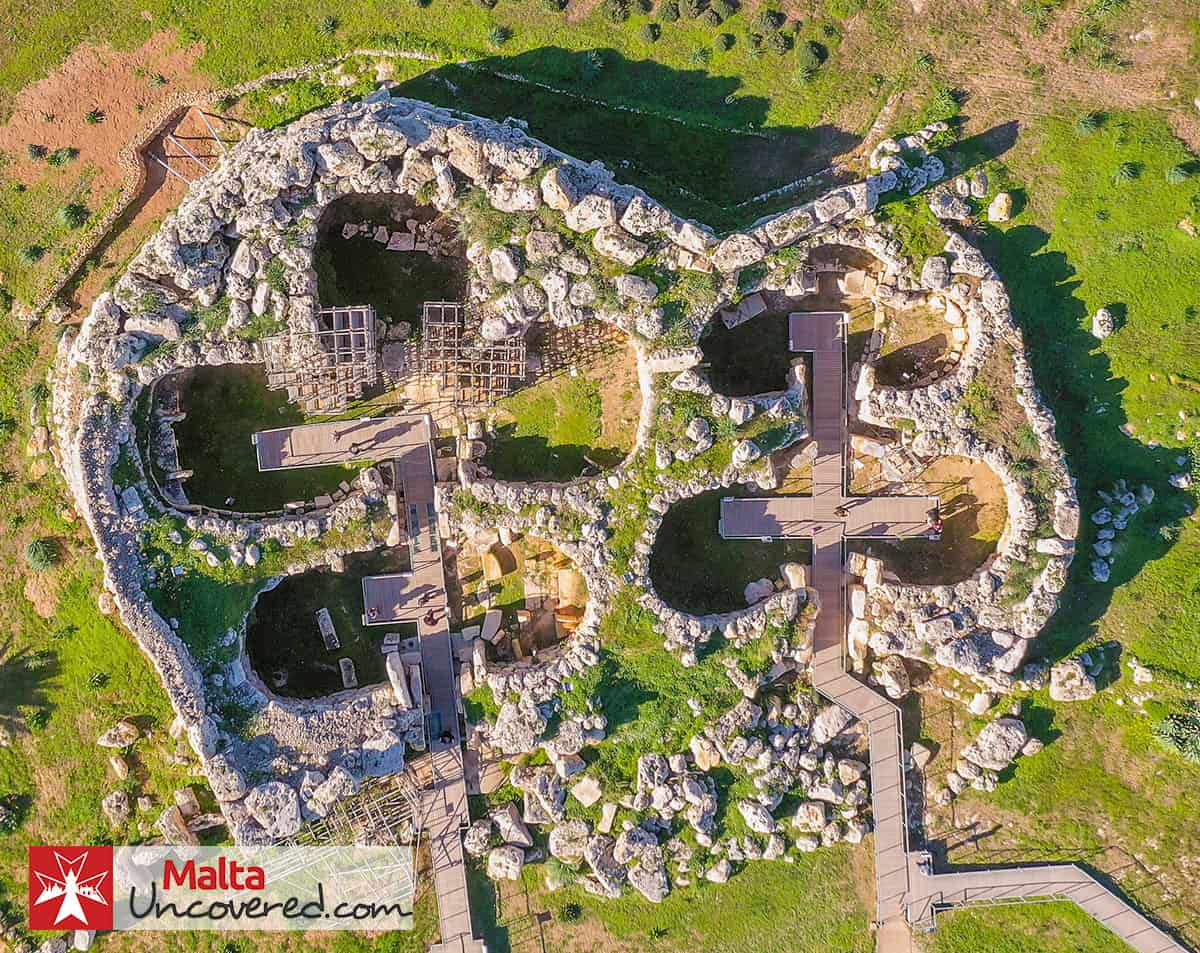
Leave a comment with your questions below and I’ll help you decide on what places to visit in Malta on your trip!

Edward is the Founder and Editor of Malta Uncovered and author of two guidebooks on Malta and Valletta.
As a tourist-turned-expat with Maltese roots, he knows the islands inside out and helps thousands of visitors enjoy a memorable trip every year.
Was this article helpful? Share it with your friends!
Get the most out of your visit to Malta with Malta Uncovered guidebooks – full of local knowledge and up-to-date for 2024!

Thank you for this info! My wife and I have been visiting since the 1960s and there are sites here that we had not discovered.
I’m happy to hear that Peter, thank you for your comment!
Traveling to Malta Thursday for two weeks with three other women. this guide was incredibly helpful. I bookmarked it and am sure I will be using while there. Any advice on getting around without renting a car? We are hoping the public transport is as good as it seems. We will be staying in Mellieha. Should we be renting a car for specific attractions or will the buses do? Thanks.
Happy to hear that Betty, thank you. There aren’t many options for transport in Mellieha really other than buses or taxis, but you should be just fine using the bus as it’s a relatively quiet time of year. Enjoy your stay!
Edward, thanks for all your info about Malta my wife and I love this small but very beautiful island we have been coming on and of for the last 12 years and we thought we had seen all to see but your website has opened an array of different things to do and see no matter what the season is. We will be
visiting again this September 2018 can’t wait.
Thank you and good luck!
I’m happy to hear that Paul, that’s exactly why I’m running the site in the first place. Have a great trip and thank you for leaving a note! 🙂
Thank you so much for such a comprehensive guide. My wife and I visited 4 years ago and love Malta so are due to visit again in September 2018. There is so much to see and experience we have booked 2 weeks and can’t wait to explore again.
Glad you like it Mark, thanks for leaving a comment!
Edward, thanks so much for all the info on Malta. My sister and I will be there towards the end of March and so look forward to seeing as many of these places as possible! We visited Malta a long time ago but didn’t see all of this. We are particularly interested in historical/ war sites. Will keep your email to refer to nearer the time! Thanks again.
You’re welcome Sonia – always happy to help!